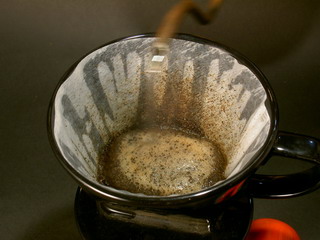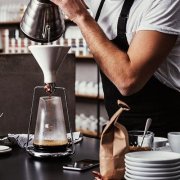Introduction to hand-brewing coffee sharing what coffee beans are used for hand-brewing coffee? Can I add milk to my hand coffee?

Professional coffee knowledge exchange more coffee bean information please follow the coffee workshop (Wechat official account cafe_style)
Coffee hand Pot recommendation-- complete Analysis of the Best hand Pot
The smell is strong and mellow--
The taste is mellow and humble--
The posture is elegant and sultry--
This is the cup of good hand-made coffee I want to drink.
A good cup of hand coffee. It's not as simple as I thought--
A good cup of hand coffee. It's much rarer than using a machine to set up a complete espresso--
A perfect cup of handmade coffee requires a good feel to achieve--
Make coffee by hand every time. And there's a different possibility--
Make coffee by hand. There are even world-class competitions--
I wanted to learn to make coffee by hand a long time ago. The reason is interesting--
Because of laziness
Because you don't want to spend a lot of time cleaning the espresso machine for a cup of espresso--
So I began to touch the coffee by hand and thought it was as simple as adding hot water, brewing coffee powder and washing a cup.
This time I took a junior hand-brewing coffee class-- drank coffee all night--
Only to find that the meaning of hand flushing is much more difficult than I, a stupid woman, thought far away.
First, let's talk about the history of hand-made coffee.
Originally, coffee was very popular in the Arab world in the 13th century. The ground coffee was poured into a pot and boiled and waited to precipitate to drink.
In the 16th century, the European court began to regard drinking coffee as a noble behavior, and began to use linen or metal mesh to filter out the coffee grounds.
In the 19th century, Melitta Merita, a German woman, made the world's first coffee filter paper from the ink paper of her workbook.
Today, there is still Melitta brand coffee filter paper (since 1905 -)
Let's talk about the factors that affect a cup of hand-made coffee--
Grinding thickness / proper water temperature / cooking time (of course, there are many other esoteric factors)
With regard to the roughness and fineness of grinding, the finer the grinding, the more the area of contact with water, and the rich extraction.
The degree of grinding is rough, the powder touches the surface of the water less, and the coffee tastes light.
Taking the Pegasus bean grinder as an example, it is suggested that 4.5-5 medium and rough grinding--
(below: thin-> thick from top to bottom)
For the part of water temperature, hand flushing suggests 88-92 degrees.
The higher the water temperature is, the more substances are extracted and the taste is rich.
The lower the temperature, the less the extract, and the more insipid and tasteless it is--
However, if the coffee beans are ground in advance, the temperature can be raised to increase the extraction flavor of coffee powder.
I remember that the part of the water quality is mainly filtered soft water, and the unfiltered hard water contains minerals, so the saturation is high, and the coffee substance is less able to integrate into the water smoothly.
It takes a long time to brew and extract a lot of coffee. Short time coffee extract few substances-appropriate time to extract appropriate flavor-
The cooking time here refers to the flow time during water injection--
Coffee utensils are mainly filter cups, filter paper (for special use with various filter cups), hand punch pots, hand punch racks, drip pots (preferably scaled), electronic scales (heat resistant), electronic thermometers, timers, etc.-
Filter cup is recommended, hand into the door is recommended to use a tapered filter cup. The velocity is fast in the big mouth and round diameter. There is no space hindrance in structural modeling-twisting and squeezing of spiral ribs increases the release of soluble matter.
On the other hand, the trapezoidal filter cup has a slow flow rate and uneven outlet holes (for example, if there is only one outflow of three mouths, the extraction is not complete).
The metal filter cup will have the problem of residual fine powder. After using flannel for a long time, there will occasionally be a bad smell in the fabric itself-* (but still use it according to personal preference)
The material of the filter cup gives priority to good thermal insulation. Copper > pottery > glass
Hand punch pot selection--
In the process of brewing, if the water temperature is stable, there is an advantage of brewing. The design of the spout and body of the kettle has different relations with the control of the speed of hot water injected into the filter cup and the control of flow rate.
Kalita's court thin-mouth pot, also known as the hand-punching King, has a copper body that keeps warm, and the novice is suitable for the thin-mouth pot, because the water flow of the thin mouth is stable and easy to control-- there is no need to worry about the water column. Of course, there are other brands of wide-mouth pots and crane-mouth pots for veterans.
The most profound and interesting thing about hand flushing is that there is no standard SOP, and any change may affect the flavor of the coffee.
Personal hand flushing current, powder-water ratio, speed, temperature, coffee powder flavor, thickness, filter cup, etc.
Of course, you can also change any of the factors--
Or, different people come to brew the same cause-- which is bound to have different flavors-- here are the most basic hand-flushing demonstration steps.
[introduction to the continuous sailor brewing method and formula of basic hot coffee]
My coffee shop filter cup brand Chemex
My coffee shop hand brew pot Kalita palace thin mouth pot
* medium and deep baked beans at 88 degrees Celsius
* Coffee powder: water reference ratio 1:11-1:18 adjusted according to personal preference
* for example, powder: water is 30g coffee powder at 1:11: 330ml water
* chemex filter cup belly button about 350ml
* about 10g per flat spoon of coffee spoon
* it is recommended that coffee powder and beans be stored in opaque packaging or bottles-do not squeeze the one-way exhaust holes in the bags-
1. Fold the filter paper first, then wet it with hot water, warm the kettle by the way, pour out the water and set it aside.
two。 Put the coffee powder in, shake it gently and make the surface even--
3. A thermometer can be used to determine that the hot water temperature drops to the desired temperature of 88-90 degrees. Start cooking.
(because I haven't bought a thermometer yet, use the schematic diagram of the class first.)
(at present, the 100 degrees hot water discharged from the heated water purifier at home should wait for about 1-2 minutes to lower the water temperature.)
4. Steam for 30 seconds. Let the air out-(pre-ground coffee powder will take less time to steam)
5. Start to steady the flow of water clockwise from the center, draw a circle of water inside and out, and then draw it back to the center--
6. Observe the water level of the navel when the coffee flows to the pot under the glass, about 330-350ml (you don't have to wait for the water in the filter paper to finish)
Because there is no heat-resistant electronic scale at home, the navel water of the Chemex filter cup is about 350ml as the dripping water level--
7. Shake the coffee in the glass pot slightly so that the concentration is uniform.
This introductory course. Tasted all kinds of hand-brewed coffee with different causes with teachers and students.
For example, different grinding particles. Different water temperatures. Different filter cups. Will get different flavors of coffee taste. Even the taste of the entrance and the flavor in the mouth will slowly change-- very interesting and esoteric--
You can also play at home and have a look.
The above is the general basic method of continuous sailor flushing, which should not be too big or small, or too fast, so that the coffee can be soaked in water for too long, which will extract bitter, astringent, sour and other bad tastes, and it is necessary to use steady water to extract stable mellow coffee flavor. it seems simple, but it takes more practice to control it. At first, the upper arm will be deliberately exerted to extract the hand flushing pot, so there will be a little muscle soreness-- you can use the other hand to hold the forearm that pours the water to help apply the force.
On the Internet, there are many hand-made methods for different filter cups or different schools, which are too broad and diverse to digest and understand, and then I have the opportunity to take advanced courses-- I will share them more deeply with you.
I love coffee-- playing with hands and feeling that the physical world closer to coffee is so interesting-- I hope you enjoy this introductory sharing article.
.
Important Notice :
前街咖啡 FrontStreet Coffee has moved to new addredd:
FrontStreet Coffee Address: 315,Donghua East Road,GuangZhou
Tel:020 38364473
- Prev

GINA Smart hand Coffee maker experience sharing which brand of smart hand coffee maker is better
Professional coffee knowledge exchange more coffee bean information please follow the coffee workshop (Wechat official account cafe_style) Coffee hand Pot recommend the best hand brewer complete analysis of Kickstarter star team, sheep's horn cup sequel, exquisite beauty versatile and practical GINA has right away! Ice drop / hand washing / soaking machine has three uses, and it can also make tea with built-in electronic scales to easily measure coffee beans and water.
- Next

Mary's hand coffee demonstration is a pleasure, not a gimmick.
Professional coffee knowledge exchange more coffee bean information please follow the coffee workshop (Wechat official account cafe_style) Coffee hand brewers recommend the best hand brewers completely explain falling in love with coffee, probably when you were in college. At that time, in order to have a place to concentrate on reading without spending any money, I would go to McDonald's after class and order an American style with unlimited refills.
Related
- Beginners will see the "Coffee pull flower" guide!
- What is the difference between ice blog purified milk and ordinary milk coffee?
- Why is the Philippines the largest producer of crops in Liberia?
- For coffee extraction, should the fine powder be retained?
- How does extracted espresso fill pressed powder? How much strength does it take to press the powder?
- How to make jasmine cold extract coffee? Is the jasmine + latte good?
- Will this little toy really make the coffee taste better? How does Lily Drip affect coffee extraction?
- Will the action of slapping the filter cup also affect coffee extraction?
- What's the difference between powder-to-water ratio and powder-to-liquid ratio?
- What is the Ethiopian local species? What does it have to do with Heirloom native species?

